Feeding Alginate-Coated Liquid Metal Nanodroplets to Silkworms for Highly Stretchable Silk Fibers
Abstract
:1. Introduction
2. Materials and Methods
3. Results and Discussion
3.1. The Preparation of LM@NaAlg Nanodroplets and Effect on Silk Fibers
3.2. Effect of LM@NaAlg in Feeding Diet on Growth and Silk of Silkworms
3.3. Thermal Degradation of Degummed Silks
3.4. Secondary Structure Characterizations of Degummed Silks
3.5. Steered Molecular Dynamics of LM@NaAlg-Modified Silk Fibers
3.6. Crystalline Structure Characterization of Silk Fibers
3.7. Stretchable Mechanical Properties of LM@NaAlg-Modified Silks
4. Conclusions
Supplementary Materials
Author Contributions
Funding
Institutional Review Board Statement
Informed Consent Statement
Data Availability Statement
Conflicts of Interest
References
- Rockwood, D.N.; Preda, R.C.; Yücel, T.; Wang, X.; Lovett, M.L.; Kaplan, D.L. Materials Fabrication from Bombyxmori Silk Fibroin. Nat. Protoc. 2011, 6, 1612–1631. [Google Scholar] [CrossRef]
- Liu, J.; Kong, T.Y.; Xiong, H.M. Mulberry Leaves Derived Red Emissive Carbon Dots for Feeding Silkworms to Produce Brightly Fluorescent Silk. Adv. Mater. 2022, 2200152. [Google Scholar] [CrossRef]
- Sayed, M.M.; Mousa, H.M.; El-Aassar, M.R.; El-Deeb, N.M.; Ghazaly, N.M.; Dewidar, M.M.; Abdal-hay, A. Enhancing mechanical and biodegradation properties of polyvinyl alcohol/silk fibroin nanofibers composite patches for Cardiac Tissue Engineering. Mater Lett. 2019, 255, 126510. [Google Scholar] [CrossRef]
- Mousa, H.M.; Hussein, K.H.; Sayed, M.M.; El-Aassar, M.R.; Mohamed, I.M.A.; Kwak, H.H.; Woo, H.M.; Abdal-hay, A. Development of biocompatible tri-layered nanofibers patches with endothelial cells for cardiac tissue engineering. Eur. Polym. J. 2020, 129, 109630. [Google Scholar] [CrossRef]
- Pritchard, E.M.; Kaplan, D.L. Silk Fibroin Biomaterials for Controlled Release Drug Delivery. Expert Opin. Drug. Del. 2011, 8, 797–811. [Google Scholar] [CrossRef]
- Zheng, X.; Zhao, M.; Zhang, H.; Fan, S.; Shao, H.; Hu, X.; Zhang, Y. Intrinsically Fluorescent Silks from Silkworms Fed with Rare-earth Upconverting Phosphors. ACS Biomater. Sci. Eng. 2018, 4, 4021–4027. [Google Scholar] [CrossRef]
- Zhang, Y.H.; Shi, M.J.; Li, K.L.; Xing, R.; Xu, S.Q. Impact of Adding Glucose-coated Water-soluble Silver Nanoparticles to the Silkworm Larval Diet on Silk Protein Synthesis and Related Properties. J. Biomat. Sci.-Polym. Ed. 2020, 31, 376–393. [Google Scholar] [CrossRef]
- Vepari, C.; Kaplan, D.L. Silk as a Biomaterial. Prog. Polym. Sci. 2007, 32, 991–1007. [Google Scholar] [CrossRef]
- Liu, Q.; Wang, X.; Tan, X.; Xie, X.; Xia, Q. Disruption of the Metal Ion Environment by EDTA for Silk Formation Affects the Mechanical Properties of Silkworm Silk. Int. J. Mol. Sci. 2019, 20, 3026. [Google Scholar] [CrossRef] [Green Version]
- Tao, H.; Amsden, J.J.; Strikwerda, A.C.; Fan, K.; Kaplan, D.L.; Zhang, X.; Averitt, R.D.; Omenetto, F.G. Metamaterial Silk Composites at Terahertz Frequencies. Adv. Mater. 2010, 22, 3527–3531. [Google Scholar] [CrossRef]
- Müller, C.; Hamedi, M.; Karlsson, R.; Jansson, R.; Marcilla, R.; Hedhammar, M.; Inganäs, O. Woven Electrochemical Transistors on Silk Fibers. Adv. Mater. 2011, 23, 898–901. [Google Scholar] [CrossRef]
- Cai, L.; Shao, H.L.; Hu, X.C.; Zhang, Y.P. Reinforced and Ultraviolet Resistant Silks from Silkworms Fed with Titanium Dioxide Nanoparticles. ACS Sustain. Chem. Eng. 2015, 3, 2551–2557. [Google Scholar]
- Fan, S.N.; Zheng, X.T.; Zhan, Q.; Zhang, H.H.; Shao, H.L.; Wang, J.X.; Cao, C.B.; Zhu, M.F.; Wang, D.; Zhang, Y.P. Super-strong and Intrinsically Fluorescent Silkworm Silk from Carbon Nanodots Feeding. Nano-Micro Lett. 2019, 11, 1–11. [Google Scholar]
- Ma, L.; Akurugu, M.A.; Andoh, V.; Liu, H.; Li, L. Intrinsically Reinforced Silks Obtained by Incorporation of Graphene Quantum Dots into Silkworms. Sci. China Mater. 2018, 62, 245–255. [Google Scholar] [CrossRef] [Green Version]
- Zhang, P.; Lan, J.; Wang, Y.; Xiong, Z.H.; Huang, C.Z. Luminescent Golden Silk and Fabric Through in situ Chemically Coating Pristine-silk with Gold Nanoclusters. Biomaterials 2015, 36, 26–32. [Google Scholar] [CrossRef]
- Lu, Z.S.; Mao, C.P.; Meng, M.; Liu, S.G.; Tian, Y.L.; Yu, L.; Sun, B.; Li, C.M. Fabrication of CeO2 Nanoparticle-modified Silk for UV Protection and Antibacterial Applications. J. Colloid. Interf. Sci. 2014, 435, 8–14. [Google Scholar] [CrossRef]
- Chang, S.Q.; Kang, B.; Dai, Y.D.; Chen, D. A Novel Route to Synthesize Cds Quantum Dots on the Surface of Silk Fibers via γ-radiation. Mater. Lett. 2008, 62, 3447–3449. [Google Scholar] [CrossRef]
- Wang, X.; Gao, W.; Xu, S.; Xu, W. Luminescent Fibers: In situ Synthesis of Silver Nanoclusters on Silk via Ultraviolet Light-induced Reduction and Their Antibacterial Activity. Chem. Eng. J. 2012, 210, 585–589. [Google Scholar] [CrossRef]
- Wang, F.; Xu, H.; Wang, Y.; Wang, R.; Yuan, L.; Ding, H.; Song, C.; Ma, S.; Peng, Z.C.; Zhao, P.; et al. Advanced Silk Material Spun by a Transgenic Silkworm Promotes Cell Proliferation for Biomedical Application. Acta Biomater. 2014, 10, 4947–4955. [Google Scholar] [CrossRef]
- Wen, H.; Lan, X.; Zhang, Y.; Zhao, T.; Wang, Y.; Kajiura, Z.; Nakagaki, M.J.M.B.R. Transgenic Silkworms (Bombyxmori) Produce Recombinant Spider Dragline Silk in Cocoons. Mol. Biol. Rep. 2010, 37, 1815–1821. [Google Scholar] [CrossRef]
- Omenetto, F.G.; Kaplan, D.L. New Opportunities for an Ancient Material. Science 2018, 329, 528–531. [Google Scholar] [CrossRef] [PubMed] [Green Version]
- Teule, F.; Miao, Y.G.; Sohn, B.H.; Kim, Y.S.; Hull, J.J.; Fraser, M.J.; Lewis, R.V.; Jarvis, D.L. Silkworms Transformed with Chimeric Silkworm/spider Silk Genes Spin Composite Silk Fibers with Improved Mechanical Properties. Proc. Natl. Acad. Sci. USA 2012, 109, 923–928. [Google Scholar] [CrossRef] [PubMed] [Green Version]
- Cheng, L.; Huang, H.; Chen, S.; Wang, W.; Dai, F.; Zhao, H.J. Characterization of Silkworm Larvae Growth and Properties of Silk Fibers After Direct Feeding of Copper or Silver Nanoparticles. Mater. Des. 2017, 129, 125–134. [Google Scholar] [CrossRef]
- Lu, H.J.; Jian, M.Q.; Yin, Z.; Xia, K.L.; Shi, S.Y.; Zhang, M.C.; Wang, H.M.; Liang, X.P.; Ma, W.G.; Zhang, X.; et al. Silkworm Silk Fibers with Multiple Reinforced Properties Obtained through Feeding Ag Nanowires. Adv. Fiber Mater. 2022. [Google Scholar] [CrossRef]
- Wang, Q.; Wang, C.; Zhang, M.; Jian, M.; Zhang, Y. Feeding Single-walled Carbon Nanotubes or Graphene to Silkworms for Reinforced Silk Fibers. Nano Lett. 2016, 16, 6695–6700. [Google Scholar] [CrossRef]
- Wang, X.; Li, Y.; Xie, K. Ca2+ and Endoplasmic Reticulum Ca2+-ATPase Regulate the Formation of Silk Fibers with Favorable Mechanical Properties. J. Insect. Physiol. 2015, 73, 53–59. [Google Scholar] [CrossRef]
- Liu, Q.; Wang, X.; Tan, X.; Xie, X.; Li, Y.; Zhao, P.; Xi, Q. A Strategy for Improving the Mechanical Properties of Silk Fiber by Directly Injection of Ferric Ions into Silkworm. Mater. Des. 2018, 146, 134–141. [Google Scholar] [CrossRef]
- Lizuka, T.; Sezutsu, H.; Tatematsu, K.I. Colored Fluorescent Silk Made by Transgenic Silkworms. Adv. Funct. Mater. 2013, 23, 5232–5239. [Google Scholar]
- Ma, L.; Andoh, V.; Liu, H.; Song, J.; Wu, G.; Li, L. Biological Effects of Gold Nanoclusters are Evaluated by Using Silkworm as a Model Animal. J. Mater. Sci. 2019, 54, 4997–5007. [Google Scholar] [CrossRef]
- Teramoto, H.; Kojima, K. Production of Bombyx Mori Silk Fibroin Incorporated with Unnatural Amino Acids. Biomacromolecules 2014, 15, 2682–2690. [Google Scholar] [CrossRef]
- Tansil, N.C.; Li, Y.; Teng, C.P.; Zhang, S.; Win, K.Y.; Chen, X.; Liu, X.Y.; Han, M.Y. Intrinsically Colored and Luminescent Silk. Adv. Mater. 2011, 23, 1463–1466. [Google Scholar] [CrossRef] [PubMed]
- Nisal, A.; Trivedy, K.; Mohammad, H.; Panneri, S.; Gupta, S.S.; Lele, A.; Manchala, R.; Kumar, N.S.; Gadgil, M.; Khandelwal, H.; et al. Uptake of Azo Dyes into Silk Glands for Production of Colored Silk Cocoons Using a Green Feeding Approach. ACS Sustain. Chem. Eng. 2014, 2, 312–317. [Google Scholar]
- Wu, Y.H.; Deng, Z.F.; Peng, Z.F.; Zhen, R.M.; Liu, S.Q.; Xing, S.T.; Li, J.Y.; Huang, D.Q.; Liu, L. A Novel Strategy for Preparing Stretchable and Reliable Biphasic Liquid Metal. Adv. Funct. Mater. 2019, 29, 1903840. [Google Scholar] [CrossRef]
- Ling, S.; Qi, Z.; Knight, D.P.; Shao, Z.; Chen, X. Synchrotron FTIR Microspectroscopy of Single Natural Silk Fibers. Biomacromolecules 2011, 12, 3344–3349. [Google Scholar] [CrossRef] [PubMed]
- Shao, J.; Zheng, J.; Liu, J.; Carr, C.M. Fourier Transform Raman and Fourier Transform Infrared Spectroscopy Studies of Silk Fibroin. J. Appl. Polym. Sci. 2010, 96, 1999–2004. [Google Scholar] [CrossRef]
- Li, X.; Li, M.; Zong, L.; Wu, X.; You, J.; Du, P.; Li, C. Liquid Metal Droplets Wrapped with Polysaccharide Microgel as Biocompatible Aqueous Ink for Flexible Conductive Devices. Adv. Funct. Mater. 2010, 28, 1804197. [Google Scholar] [CrossRef]
- Mouriño, V.; Newby, P.; Pishbin, F.; Cattalini, J.P.; Lucangioli, S.; Boccaccini, A.R. Physicochemical, Biological and Drug-release Properties of Gallium Crosslinked Alginate/nanoparticulate Bioactive Glass Composite Films. Soft Matter 2011, 7, 6705–6712. [Google Scholar] [CrossRef]
- Song, P.; Zhang, D.Y.; Yao, X.H.; Feng, F.; Wu, G.H. Preparation of a Regenerated Silk Fibroin Film and Its Adsorbability to Azo Dyes. Int. J. Biol. Macromol. 2017, 102, 1066–1072. [Google Scholar] [CrossRef]
- Pan, H.; Zhang, Y.P.; Shao, H.; Hu, X.C.; Li, X.H.; Tian, F.; Wang, J. Nanoconfined Crystallites Toughen Artificial Silk. J. Mater. Chem. B 2014, 2, 1408. [Google Scholar] [CrossRef]
- Ming, J.; Pan, F.; Zuo, B. Influence Factors Analysis on the Formation of Silk I Structure. Int. J. Biol. Macromol. 2015, 75, 398–401. [Google Scholar] [CrossRef]
- Yu, D.; Kang, G.; Tian, W.; Lin, L.; Wang, W. Preparation of Conductive Silk Fabric with Antibacterial Properties by Electroless Silver Plating. Appl. Surf. Sci. 2015, 357, 1157–1162. [Google Scholar] [CrossRef]
- Nova, A.; Keten, S.; Pugno, N.M.; Redaelli, A.; Buehler, M.J. Molecular and Nanostructural Mechanisms of Deformation, Strength and Toughness of Spider Silk Fibrils. Nano Lett. 2010, 10, 2626–2634. [Google Scholar] [CrossRef] [PubMed] [Green Version]
- Keten, S.; Xu, Z.; Ihle, B.; Buehler, M. Nanoconfinement Controls Stiffness, Strength and Mechanical Toughness of β-sheet Crystals in Silk. Nat. Matr. 2010, 9, 359–367. [Google Scholar] [CrossRef]
- Wang, J.T.; Li, L.L.; Zhang, M.Y. Directly Obtaining High Strength Silk Fiber from Silkworm by Feeding Carbon Nanotubes. Mater. Sci. Eng. C-Mater. 2014, 34, 417–421. [Google Scholar] [CrossRef]
- Yin, Z.; Liang, X.P.; Zhou, K.; Li, S.; Lu, H.J.; Zhang, M.C.; Wang, H.M.; Xu, Z.P.; Zhang, Y.Y. Biomimetic Mechanically Enhanced Carbon Nanotube Fibers by Silk Fibroin Infiltration. Small 2021, 17, 19. [Google Scholar] [CrossRef] [PubMed]
- Guo, Z.; Xie, W.; Gao, Q.; Wang, D.; Zhao, L. In Situ Biomineralization by Silkworm Feeding with Ion Precursors for the Improved Mechanical Properties of Silk Fiber. Int. J. Biol. Macromol. 2018, 109, 21–26. [Google Scholar] [CrossRef] [PubMed]
- Liang, J.W.; Zhang, X.N.; Ji, Y.S.; Chen, Z.Y.; Norton, M.L.; Wang, Y.X.; Yan, C.; Zheng, X.; Zhu, Y.; Cheng, G.T. Feeding Silkworms with HPMC Dispersed MoO2 NPs: An Efficient Strategy to Enhance the Supercapacitance Performance of Carbonized Silk. Compos. Sci. Technol. 2021, 215, 109025. [Google Scholar] [CrossRef]
- Wu, C.; Egawa, S.; Kanno, T.; Kurita, H.; Wang, Z.; Iida, E.; Narita, F. Nanocellulose Reinforced Silkworm Silk Fibers for Application to Biodegradable Polymers. Mater. Des. 2021, 202, 109537. [Google Scholar] [CrossRef]
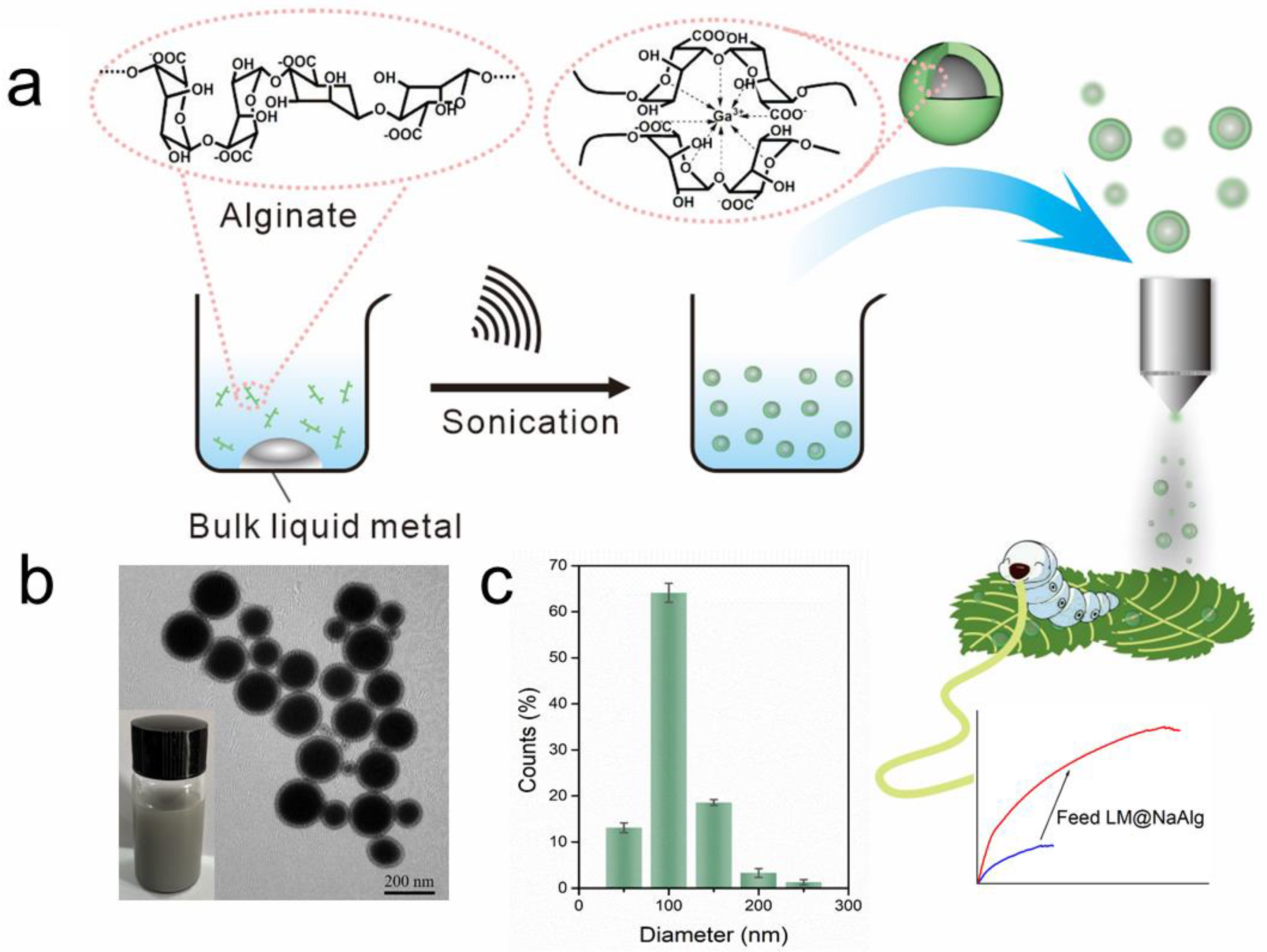

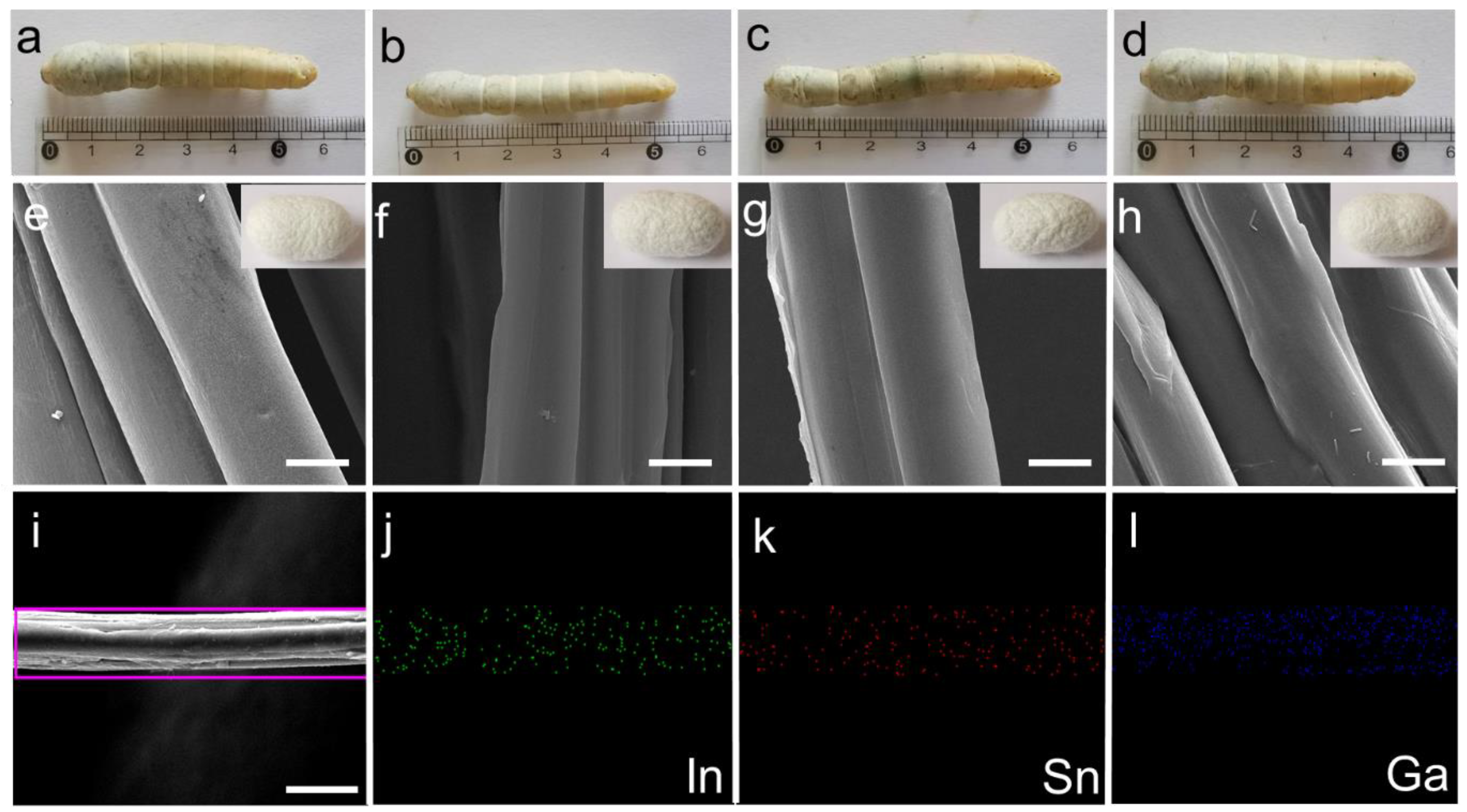
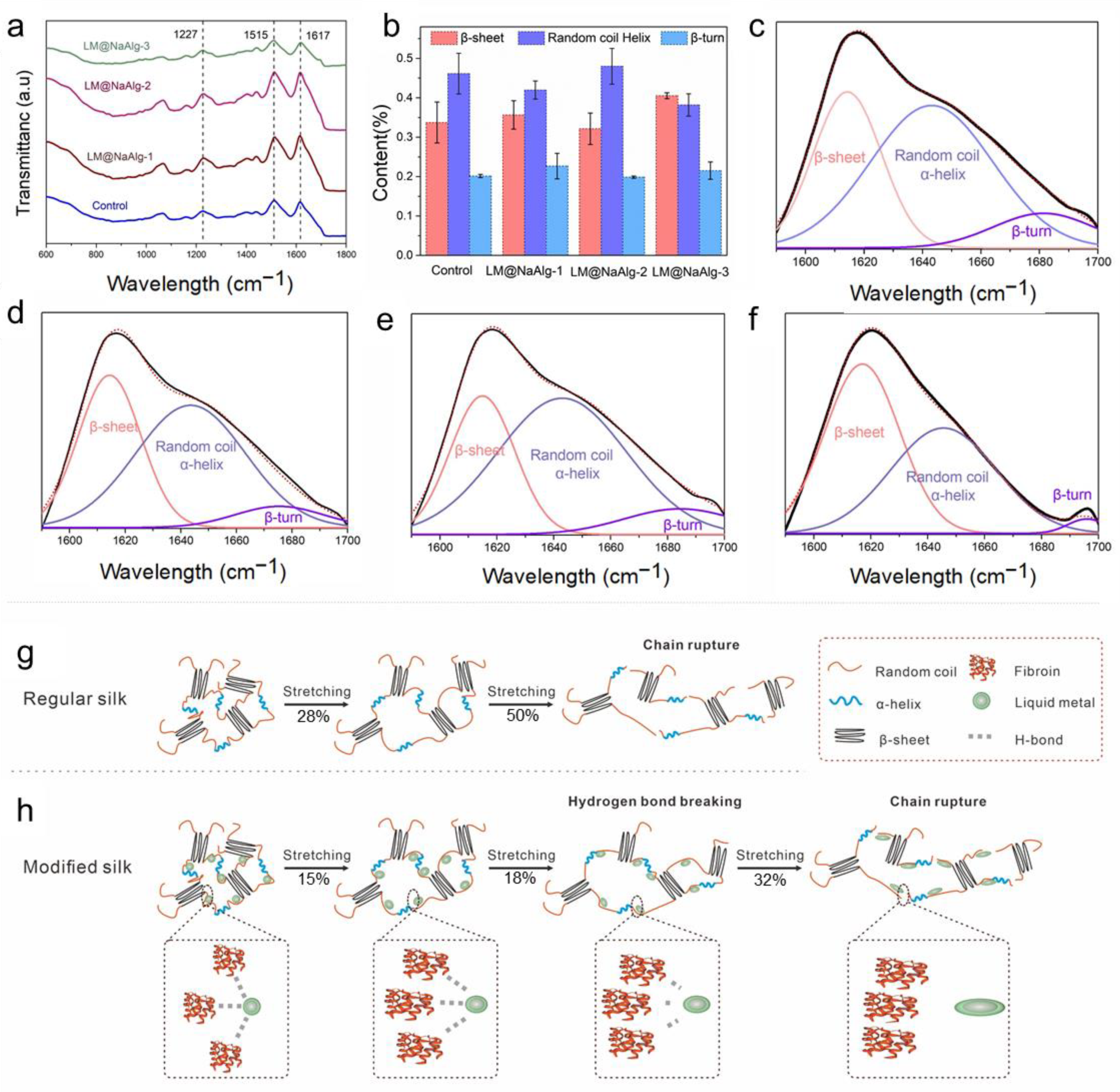
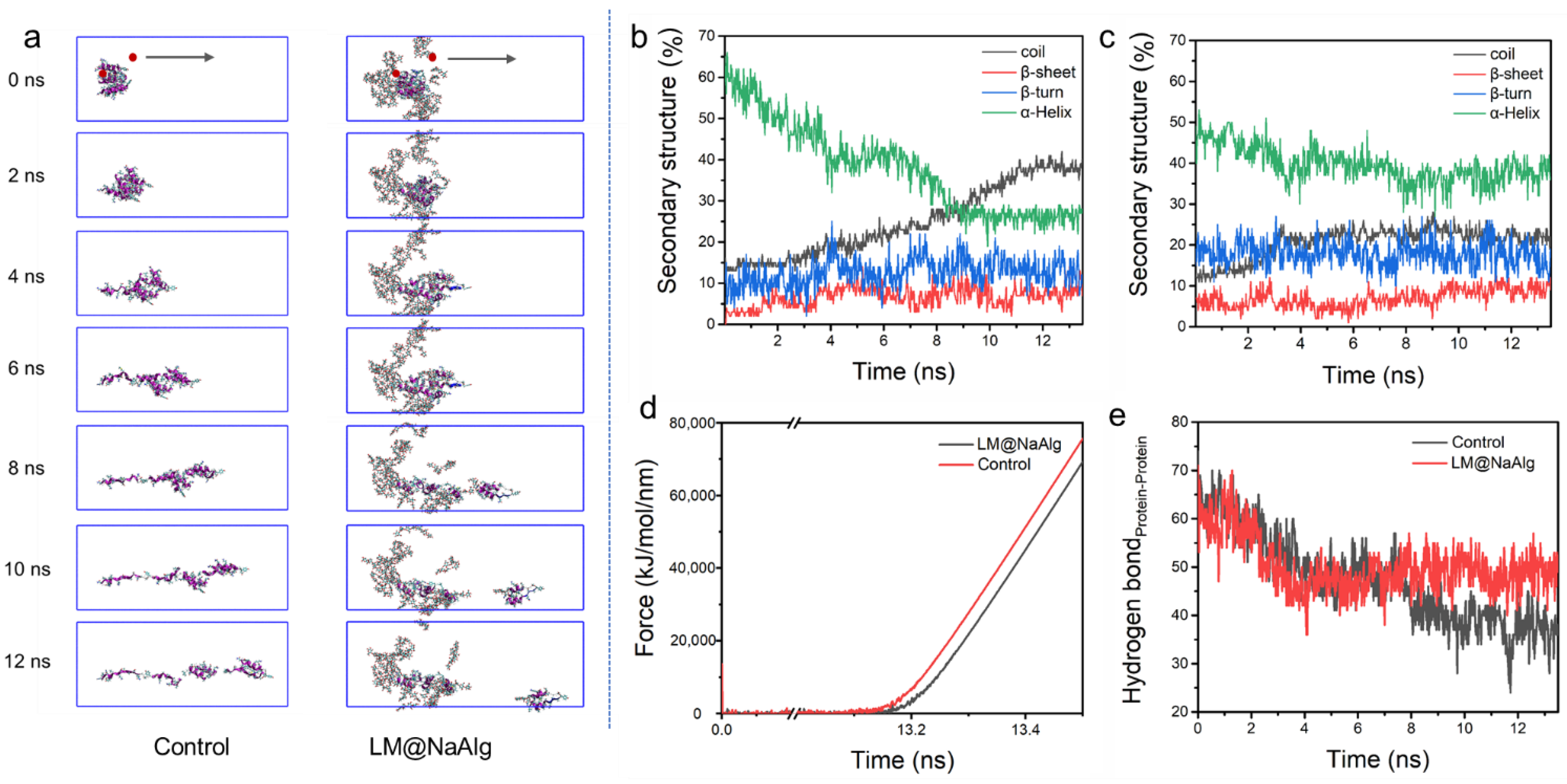
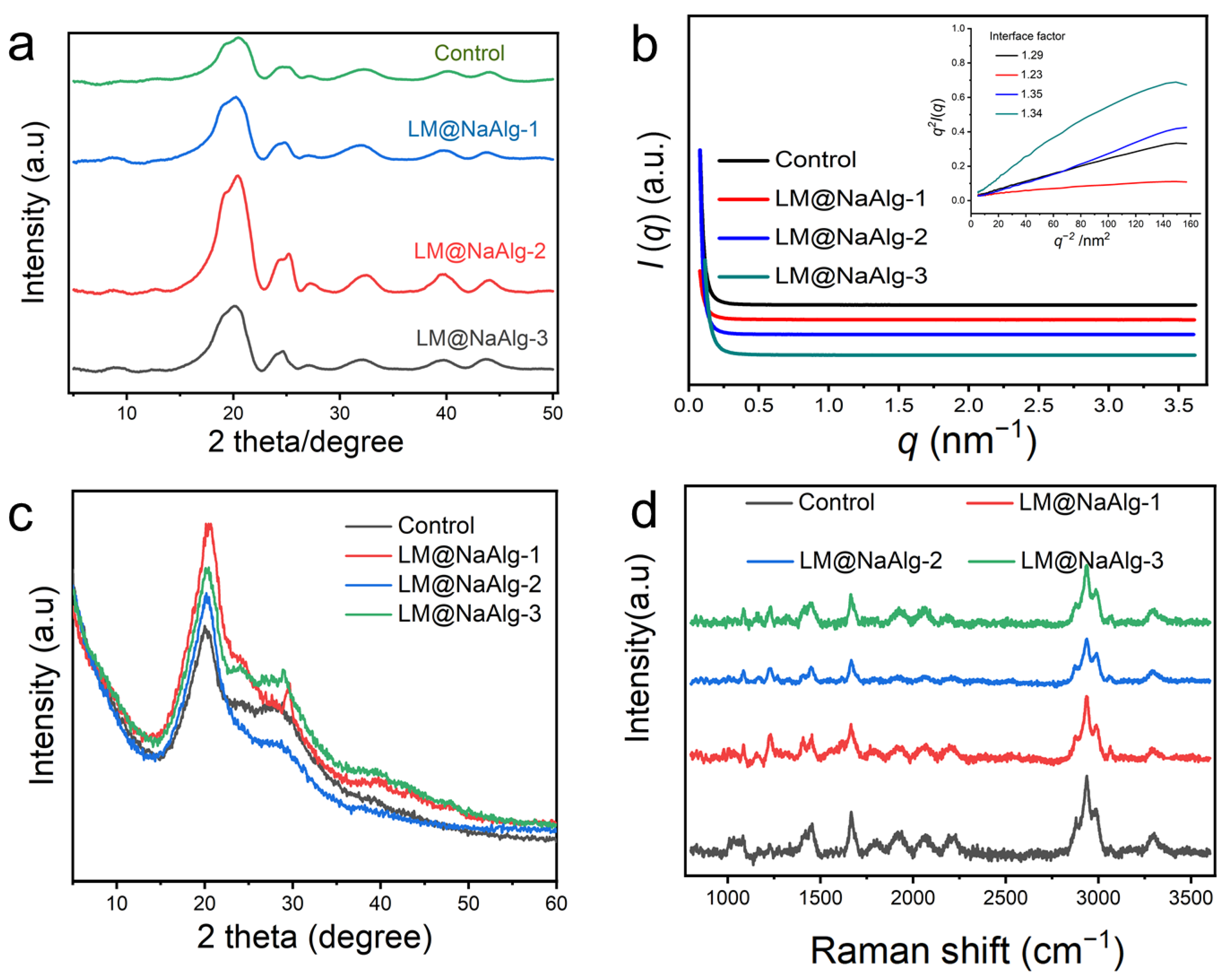

| Sample | Breaking Strength Ratio | Breaking Elongation Ratio | Young’s Modulus Ratio | Reference |
|---|---|---|---|---|
| Liquid metal | 4.06 | 2.5 | 1.25 | The present study |
| Cu | 1.3 | 1 | 1.2 | [23] |
| Ag | 1.2 | 1 | 1.1 | [23] |
| MW CNT | 2.1 | 1.4 | 2.7 | [44] |
| SW CNT | 0.8–1.7 | 0.6–1.3 | 1.0–1.2 | [25] |
| Graphene | 0.8–1.6 | 0.4–1.1 | 1.1–1.5 | [25] |
| TiO2 | 0.6–1.4 | 0.4–1.4 | 0.9–1.5 | [12] |
| Fe | 1.5 | 1.25 | 1.08 | [23] |
| CNTS | 3.5 | 2.3 | 5.42 | [45] |
| GQDs | 1.4 | 1.2 | 1.7 | [14] |
| Ca2+PO43− | 1.4 | 0.83 | 1.86 | [46] |
| HPMC-MoO2 | 1.29 | 1.36 | 1.66 | [47] |
| CNF | 1.8 | 1.26 | 2.1 | [48] |
Publisher’s Note: MDPI stays neutral with regard to jurisdictional claims in published maps and institutional affiliations. |
© 2022 by the authors. Licensee MDPI, Basel, Switzerland. This article is an open access article distributed under the terms and conditions of the Creative Commons Attribution (CC BY) license (https://creativecommons.org/licenses/by/4.0/).
Share and Cite
Gao, Z.-F.; Zheng, L.-L.; Fu, W.-L.; Zhang, L.; Li, J.-Z.; Chen, P. Feeding Alginate-Coated Liquid Metal Nanodroplets to Silkworms for Highly Stretchable Silk Fibers. Nanomaterials 2022, 12, 1177. https://doi.org/10.3390/nano12071177
Gao Z-F, Zheng L-L, Fu W-L, Zhang L, Li J-Z, Chen P. Feeding Alginate-Coated Liquid Metal Nanodroplets to Silkworms for Highly Stretchable Silk Fibers. Nanomaterials. 2022; 12(7):1177. https://doi.org/10.3390/nano12071177
Chicago/Turabian StyleGao, Zhong-Feng, Lin-Lin Zheng, Wen-Long Fu, Lei Zhang, Jin-Ze Li, and Pu Chen. 2022. "Feeding Alginate-Coated Liquid Metal Nanodroplets to Silkworms for Highly Stretchable Silk Fibers" Nanomaterials 12, no. 7: 1177. https://doi.org/10.3390/nano12071177






